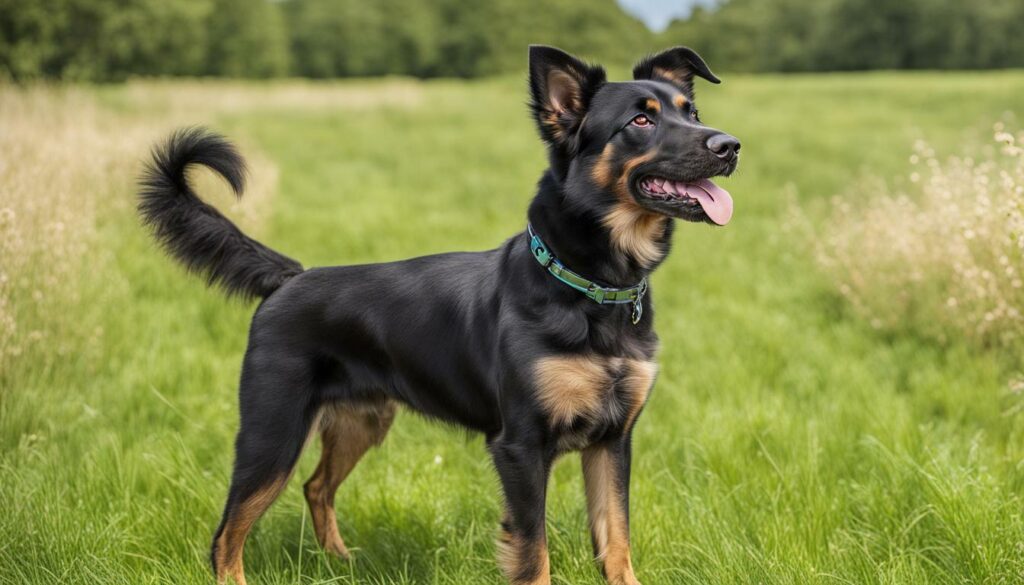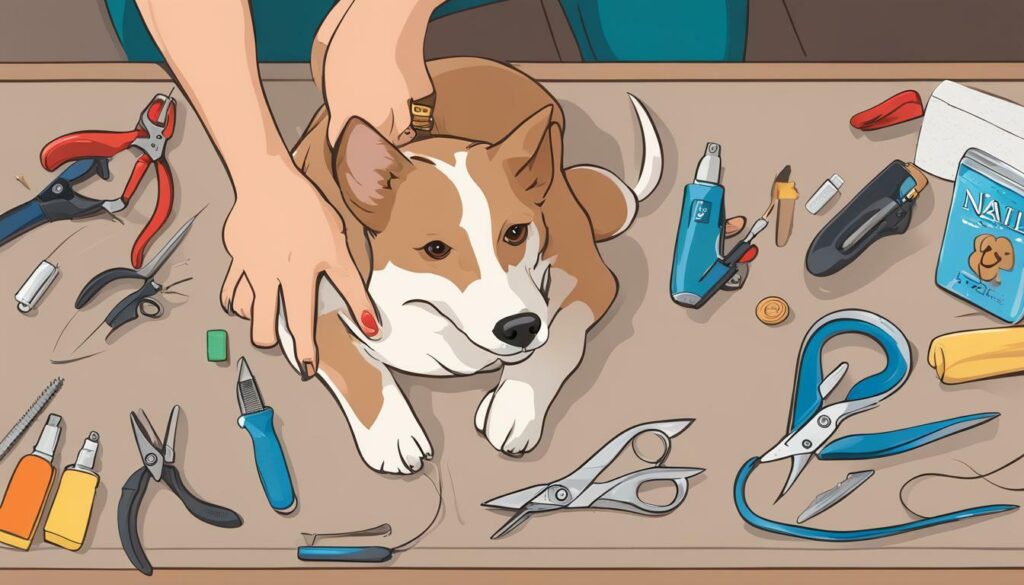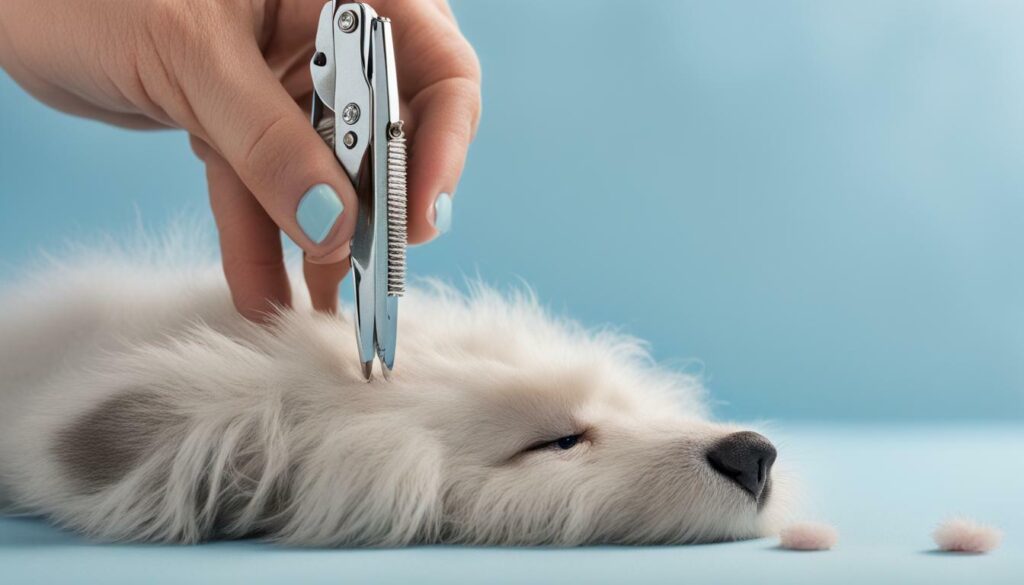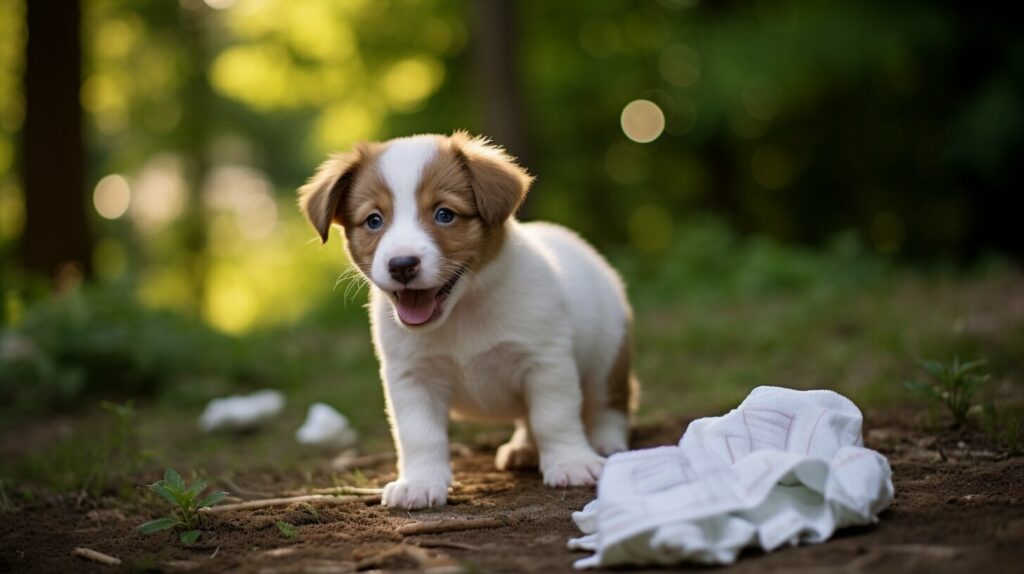As a pet owner, you want to provide the best care for your furry friend. Besides feeding and exercising, grooming is an essential aspect of pet care. One of the most crucial grooming practices for dogs is nail clipping. Knowing how to clip your dog’s nails properly can save you a lot of money and avoid any potential health issues, making it an important part of pet grooming.
However, many pet owners neglect this aspect of grooming, leading to long and sharp nails that can cause discomfort, pain, and even injury to your dog. That’s why we have created this guide to highlight the importance of dog nail trimming and provide tips and tricks for successful nail clipping sessions.
Key Takeaways:
- Dog nail clipping is an essential aspect of pet grooming.
- Neglecting to clip your dog’s nails can lead to discomfort, pain, and potential health issues.
- Proper nail trimming techniques can save you money and ensure your pet’s overall well-being.
Why Nail Clipping is Important for Dogs’ Health
As a responsible pet owner, it is essential to keep your dog’s nails trimmed regularly. Most dogs‘ nails require trimming every 3-4 weeks, depending on the breed and lifestyle. Neglecting nail trimming for dogs can result in various health problems, including discomfort, pain, and infection.
Long nails can cause your dog to have an uneven gait, which can lead to joint pain and arthritis. Additionally, overgrown nails can get caught on carpets or furniture, causing your pet to injure themselves. If the nails are left untrimmed for too long, they can curl under and grow into the paw pads, causing severe pain and infection.
Regular nail trimming for dogs is crucial to maintaining their overall health and well-being. Neglecting this essential aspect of pet grooming can cause long-term damage and discomfort for your furry friend. Therefore, it is vital to prioritize nail clipping as part of pet care.
Next in our guide, we will discuss the tools and equipment needed for a smooth and safe nail clipping process.


Tools and Equipment for Nail Clipping
Clipping your dog’s nails requires the right tools and equipment to ensure a safe and efficient process. You will need a good pair of dog nail clippers, which come in two main types: guillotine and scissor clippers. Guillotine clippers work by cutting the nail with a small, retractable blade, while scissor clippers operate like regular scissors. Choose the type that works best for you and your dog.
In addition to clippers, you will also need styptic powder or cornstarch, which helps stop the bleeding if you accidentally cut the nail too short. It’s also a good idea to have treats on hand to help your dog stay calm and reward them for good behavior during the trimming process. A non-slip mat or towel may also be helpful to prevent your dog from slipping during the procedure.
| Type of Tool/Equipment | Description |
|---|---|
| Dog nail clippers | One of the most important tools needed for clipping your dog’s nails. Choose between guillotine and scissor clippers. |
| Styptic powder or cornstarch | Helps stop bleeding in case of accidental over-trimming. |
| Treats | Can be used to help keep your dog calm and good behavior. |
| Non-slip mat or towel | Useful in preventing your dog from slipping during the trimming process. |
Professional dog nail clipping services can also be a good option if you are uncomfortable or unsure about performing the procedure yourself. Trained professionals have the necessary tools and expertise to ensure a quick and easy process.
Step-by-Step Guide on How to Clip Your Dog’s Nails
Trimming your dog’s nails can seem daunting, but with the right tools and techniques, it can be a stress-free experience for both you and your pet. Here’s a step-by-step guide on how to trim your dog’s nails:
Step 1: Gather Your Tools
Make sure you have all necessary tools before starting the clipping process. You’ll need a pair of dog nail clippers, styptic powder (in case of bleeding), and treats to reward your dog for good behavior.
Step 2: Familiarize Your Dog with the Clippers
Before you start clipping, it’s important to get your dog comfortable with the nail clippers. Let them sniff the clippers and handle them so they become familiar with the tool.
Step 3: Find the Quick
The quick is a pinkish area in the nail that contains blood vessels and nerves. It’s important not to clip the quick as it can cause bleeding and pain. The quick is easier to see in dogs with light-colored nails, but it can be more difficult to spot in dogs with dark nails. As a rule of thumb, only clip the tip of the nail and avoid the area near the quick.
Step 4: Begin Clipping
Hold your dog’s paw firmly and use the clippers to trim the nail at a slight angle, taking off only the tip. Make sure you avoid the quick. If you’re unsure, it’s better to err on the side of caution and clip less. Repeat the process for each nail, giving your dog a treat after each one.
Step 5: File the Nails
After clipping, use a nail file to smooth out any rough edges. This will prevent your dog from snagging their nails on surfaces and reduce the likelihood of injury.
Remember to take your time and be patient. If your dog becomes anxious or restless, take a break and try again later. With practice, you’ll become more comfortable with the process and your dog will learn to trust you during nail clipping sessions.


Following these steps will ensure that your dog’s nails are trimmed safely and effectively. With regular nail maintenance, your pet will enjoy improved mobility and better overall health.
Understanding the Anatomy of a Dog’s Nail
Before attempting to clip your dog’s nails, it’s essential to understand the different parts that make up their nail. Each nail consists of the following:
| Part | Description |
|---|---|
| The Claw | The hard outer covering that protects the inner parts of the nail. |
| The Quick | The sensitive inner part of the nail containing blood vessels and nerves. It appears pink and should be avoided during clipping. |
| The Bed | The fleshy area underneath the nail where hair and sweat glands are located. |
It’s important to note that the quick varies in length and can be challenging to identify, especially in dogs with dark nails. Cutting into the quick can be painful for your dog and result in bleeding, so it’s crucial to proceed with caution and use proper lighting.
However, it’s possible to prevent accidental cutting of the quick by regularly trimming the nails. When you clip the nail, the quick recedes, and the nail’s overall length decreases. Regular clipping leads to shorter nails and a shorter quick, making it easier to identify and avoid the quick during future clippings.
Now that you understand the anatomy of a dog’s nail, you can approach the clipping process with confidence and care. In the next section, we’ll explore common signs that indicate when your dog’s nails need clipping.
Signs Your Dog’s Nails Need Clipping
Regular nail trimming is a crucial part of your dog’s grooming routine. Long nails not only make it difficult for them to walk and stand but can also cause discomfort and pain.
One of the most common signs that your dog’s nails need clipping is the clicking sound they make when walking on hard surfaces. If you hear this, it means that their nails are too long and need trimming. Another visible sign is when the nails grow past the paw pads. This can cause painful cracking, splitting, and even infection.
Additionally, if your dog starts biting or licking their nails frequently, it could be a sign that they are experiencing discomfort. You may also notice changes in their gait or reluctance to walk or play, indicating that their nails need attention.
For professional dog nail clipping, look for a reputable pet grooming service that can provide safe and efficient trimming. However, with the right tools and techniques, DIY nail clipping can also be an effective option for pet owners.
Remember, maintaining your dog’s nail hygiene is essential to their overall health and well-being. By keeping an eye out for these signs and regularly checking and clipping their nails, you can ensure that your furry friend is happy and healthy.
Overcoming Challenges and Handling Difficult Dogs
Clipping your dog’s nails can be a challenging task, especially if your pet is anxious or uncooperative. However, with a little patience and the right approach, you can make the process less stressful for both of you.
One of the most important things to keep in mind is to stay calm and avoid rushing. Dogs can sense your anxiety, so it’s essential to maintain a relaxed and confident demeanor. Here are some additional tips to help you overcome common challenges and handle difficult dogs:
- Start early: Introduce your dog to nail clippers and handling their paws when they’re still a puppy. This will help them get used to the process and make them less fearful as they grow older.
- Use positive reinforcement: Reward your dog with treats and praise throughout the clipping process. This will help them associate the experience with positive emotions and make it more enjoyable for them.
- Take breaks: If your dog is getting restless or anxious, take a break and resume the clipping process later. This will prevent them from associating the experience with negative emotions and make it easier for you to finish the task later.
- Ask for help: If your dog is particularly difficult to handle, consider asking for help from a friend or a professional groomer. They can assist you in holding your dog and making the process quicker and safer.
Remember, every dog is different, and what works for one may not work for another. Don’t be discouraged if it takes a few attempts to find the right approach for your pet.
Overall, proper pet grooming is essential for the health and well-being of your dog. By following these tips and taking a patient and calm approach, you can make nail clipping a stress-free experience for both you and your pet.
Alternatives to DIY Nail Clipping
If you’re not comfortable clipping your dog’s nails yourself, or if your dog is particularly difficult or anxious, there are alternatives to DIY nail clipping that may work better for you and your pet. Consider seeking professional pet grooming services for your dog’s nail trimming needs.
A professional groomer has experience handling a variety of breeds and temperaments and can clip your dog’s nails safely and efficiently. They also have access to specialized tools and equipment, such as nail grinders, that can make the process more comfortable for your pet.
Professional dog nail clipping services are available at many pet stores, veterinary clinics, and grooming salons. Some pet groomers even offer mobile services, where they come to your home to groom your pet.
Keep in mind that professional grooming services may come at a higher cost than DIY nail clipping, but it can be worth it for the peace of mind and convenience. Plus, you’ll be supporting a local business that specializes in pet care.
Whether you choose to clip your dog’s nails yourself or seek professional assistance, remember that regular nail trimming is a crucial aspect of pet grooming. By keeping your dog’s nails at an appropriate length, you’ll ensure their comfort and overall health.
Tips for Post-Nail Clipping Care
After successfully trimming your dog’s nails, it’s important to take proper care to ensure their continued health. Here are some essential tips for post-nail clipping care:
- Inspect the nails: After cutting your dog’s nails, examine them to ensure they are free from any cracks or splits. If you notice any issues, seek veterinary attention.
- Clean the nails: Use a clean cloth or cotton ball to wipe away any debris or dust from the nails. This can help prevent infection.
- Apply styptic powder: If you accidentally cut the quick, causing bleeding, apply styptic powder to the affected area to stop the bleeding. Follow the instructions on the product label.
- Offer treats: Reward your dog with treats or positive reinforcement to make the experience more pleasant and show them that nail clipping isn’t a scary process.
- Take your time: Allow your dog to rest and relax after the nail clipping session, and avoid activities that may damage the newly trimmed nails.
By following these tips, you can ensure that your dog’s nails remain healthy and strong. Remember, regular nail clipping is a crucial aspect of proper grooming for your furry friend.
Conclusion
Congratulations on completing this guide on dog nail clipping! You now have the knowledge and tools to perform this essential aspect of pet grooming with confidence and ease. Remember, regular nail trimming is crucial for your dog’s health and well-being, so make sure to dedicate time to this task.
By following the tips outlined in this guide, you can ensure a safe and stress-free experience for both you and your furry friend. Always remember to use proper equipment, take precautions during the process, and be patient with your pet.
If you encounter any challenges, don’t hesitate to seek professional assistance. Many pet grooming services offer nail clipping as part of their packages, which can be a great option for busy pet owners or those with particularly difficult pets.
Thank you for prioritizing your pet’s grooming needs and taking the time to learn more about dogs nail clipping. Your furry friend will thank you for it!
FAQ
Q: Why is nail clipping important for dogs’ health?
A: Regular nail clipping is important for dogs’ health because long nails can cause discomfort, pain, and potential injury. Overgrown nails can affect a dog’s gait and make it difficult for them to walk or run properly. Additionally, long nails can get caught on surfaces and tear, leading to bleeding and infection. Trimming a dog’s nails helps maintain their overall well-being.
Q: What tools and equipment do I need for nail clipping?
A: To clip your dog’s nails, you’ll need a pair of dog nail clippers or a Dremel tool, styptic powder to stop bleeding in case of accidental cuts, and a nail file to smooth any sharp edges. It’s also helpful to have treats nearby to reward your dog during the process.
Q: How do I clip my dog’s nails safely?
A: To safely clip your dog’s nails, follow these steps:
1. Choose a quiet and well-lit area.
2. Hold your dog’s paw gently and use the clippers or Dremel tool to trim a small piece of the nail at a time, avoiding the quick (the pink part).
3. If you accidentally cut the quick and there is bleeding, apply styptic powder to stop it.
4. Remember to file the nails afterward to remove any sharp edges.
5. Reward your dog with treats and praise throughout the process to create a positive association with nail clipping.
Q: How often should I clip my dog’s nails?
A: The frequency of nail clipping depends on your dog’s activity level and lifestyle. On average, most dogs need their nails trimmed every 2 to 4 weeks. However, dogs who spend more time outdoors or have naturally fast-growing nails may require more frequent trims. Monitoring the length of your dog’s nails regularly will help determine when they need clipping.
Q: Can I clip my dog’s nails at home or should I seek professional help?
A: Many pet owners successfully clip their dog’s nails at home. However, if you’re unsure or uncomfortable with the process, or if your dog is particularly anxious or difficult to handle, seeking professional help from a groomer or veterinarian is a good option. They have the experience and expertise to trim nails safely and efficiently.
Q: What are the signs that my dog’s nails need clipping?
A: Some signs that indicate your dog’s nails need clipping include:
– Clicking sound when they walk on hard surfaces.
– Nails touching the ground when standing.
– Difficulty walking or discomfort.
– Nails curling or growing into the paw pads.
– Visible splits or cracks in the nails.
– Excessive scratching or pawing at their nails.
Q: How do I handle a difficult or anxious dog during nail clipping?
A: Handling a difficult or anxious dog during nail clipping can be challenging. Here are some tips:
– Gradually desensitize your dog to the process by associating it with positive experiences and rewards.
– Use gentle restraint techniques or consider using a muzzle if necessary.
– Practice patience and take breaks if your dog becomes too stressed or agitated.
– Consider seeking professional assistance if you’re unable to safely manage the situation.



